Exercises (2276)
Lunge forwards alternating ► forward lunge
Power
Individual work


Stand upright, arms supported on the hips, folded across the chest or in front, lunge forwards, bend the front (and back) leg to a right angle (back knee briefly touches the floor), push off the front leg to return to the starting position. Switch sides for the next exercise.
Attention:
Always keep the front knee behind the tip of the foot and centred over the foot. Distribute your weight over the entire front foot. Keep an upright posture (tense torso), push your front knee outwards (do not tilt it inwards).
Lighten:
Lower your upper body less (greater angle at the knees).
Harden:
Additional weight (on the shoulders, with hanging arms or in a forward or upright position).
Variant I:
Push off the back leg to return to the standing position. The lunge creates locomotion.
Variant II:
Instead of bringing the front leg to a standing position, the back leg is brought directly forwards and the knee is bent (new lunge), creating continuous locomotion.
1 weight vest/weight disc/(medicine) ball/barbell/sandbag/fighting backpack/2 dumbbells ► make the exercise more difficult (additional weight)
Lunge forwards alternating ► forward lunge
Power
Individual work

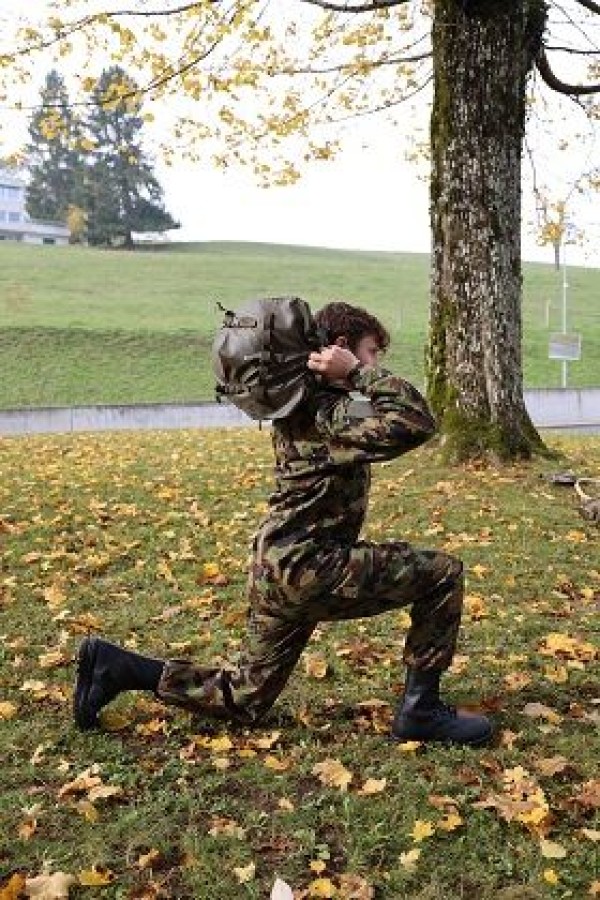
Stand upright, hold an object placed on your shoulder or neck (e.g. sandbag or rucksack) with your hands, lunge forwards, bend your front (and back) leg to a right angle (back knee briefly touches the floor), push off your front leg to return to the starting position. Switch sides for the next exercise.
Attention:
Always keep the front knee behind the tip of the foot and centred over the foot. Distribute your weight over the entire front foot. Keep an upright posture (tense torso), push the front knee outwards (do not tilt inwards).
Lighten:
Less weight/load; lower the upper body less (greater angle in the knees).
Harden:
More weight/increased load.
Variant I:
Push off the back leg to return to the standing position. The lunge creates locomotion.
Variant II:
Instead of bringing the front leg to the standing position, the back leg is brought directly forwards and the knee is bent (new lunge), creating continuous locomotion.
1 combat rucksack/sandbag (medium weight)
1 sandbag (light) ► make the exercise easier
1 weight vest/sandbag (heavy) ► make the exercise more difficult (additional weight)
Lunge forwards alternating with extension and flexion of the arms ► lunge & overhead press
Power
Individual work



Stand upright, place the barbell on your shoulder/neck or hold it in front of your chest and hold it with your hands more than shoulder-width apart. Lunge forwards, bend your front (and back) leg to a right angle (back knee practically on the floor), simultaneously straighten your arms and push the barbell upwards. Then bring the back leg forwards to perform another lunge (forwards movement). With each lunge, the weight is pushed upwards once (in the low lunge position, the arms are extended; in the upright single-leg position, the barbell is in the starting position).
Attention:
Always keep your front knee behind the tip of your foot and centred over your foot. Distribute your weight over the entire front foot. Keep an upright posture (no hollow back, tense torso), push your front knee outwards (do not tilt inwards).
Lighten:
Less weight/load; lower your upper body less (greater angle in the knees).
Harden:
More weight/greater load.
Variant I:
Attach a weight disc to both ends of the barbell with an elastic band. Due to the instability created by the swinging weight, the variation of the exercise also promotes sensorimotor skills and the exercise is significantly more challenging.
Variant II:
Push off the front leg to return to the standing position (no movement).
1 barbell
2 elastic bands and (small) weight discs ► variation of the exercise
Lunge forwards alternating with extension and flexion of the arms ► lunge & overhead press
Power
Individual work




Stand with your hips wide apart, hold the weight in front of your body, lunge forwards (approx. 60-90 cm), lower your hips to the floor until the back of your leg is parallel to the floor, bend your front leg to a right angle. From this position, the front lift is performed by raising the arms so that the weight is finally overhead. After a short pause in the lunge position with the arms held high, the front leg is pushed down to return to the standing position. Switch sides for the next exercise.
Attention:
Always keep the front knee behind the tip of the foot and centred over the foot. Distribute your weight over the entire front foot. Stand upright (tense torso), push the front knee outwards (do not tilt inwards).
Lighten:
Less or no additional weight; lower the upper body less (greater angle in the knees).
Harden:
More weight.
Variant I:
Push off the back leg to return to the standing position. The lunge creates locomotion.
Variant II:
Instead of bringing the front leg to the standing position, the back leg is brought directly forwards and the knee is bent (new lunge), creating continuous locomotion.
1 medicine ball/weight disc/dumbbell
1 weight waistcoat ► to make the exercise more difficult (additional weight)
Lunge forwards alternating with rotation of the upper body
Power
Individual work
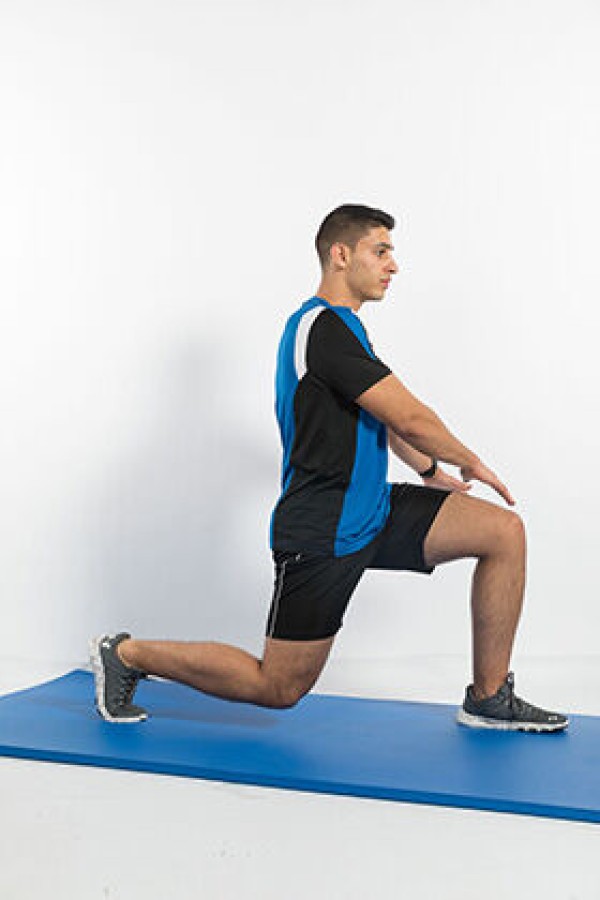

Stand upright, arms stretched as far as possible in front, lunge forwards, bend the front (and back) leg to a right angle, rotate the upper body to the side of the front leg and back in the lunge position (look at the movement), push off the front leg to return to the starting position. Switch sides for the next exercise.
Attention:
Always keep the front knee behind the tip of the foot and centred over the foot. Distribute weight over the entire foot. Stand upright (tense torso), push the front knee outwards (do not tilt inwards).
Lighten:
Lower the upper body less (greater angle in the knees).
Harden:
Additional weight (hold in hands).
Variant I:
Push off the back leg to return to the standing position. The lunge creates locomotion.
Variant II:
Instead of bringing the front leg back to the standing position, the back leg is brought forwards and the knee is bent (new lunge), creating continuous locomotion.
1 weight vest/weight disc/(medicine) ball/1-2 dumbbells ► make the exercise more difficult (additional weight)
Lunge forwards alternating with rotation of the upper body
Power
Individual work







When standing upright, hold an object (e.g. helmet or rucksack) at chest height with arms almost outstretched, lunge forwards, bend the front (and back) leg to a right angle (back knee briefly touches the floor), rotate the upper body/object to the side of the front leg and back in the lunge position (gaze accompanies the movement), push off the front leg to return to the standing position in the starting position. Switch sides for the next exercise.
Attention:
Always keep the front knee behind the tip of the foot and centred over the foot. Distribute your weight over the entire front foot. Keep an upright posture (tense torso), push the front knee outwards (do not tilt inwards).
Lighten:
Less weight/load; lower the upper body less (greater angle in the knees).
Harden:
More weight/increased load.
Variant I:
Push off the back leg to return to the standing position. The lunge creates locomotion.
Variant II:
Instead of bringing the front leg to the standing position, the back leg is brought directly forwards and the knee is bent (new lunge), creating continuous locomotion.
1 combat rucksack/weight plate/dumbbell
1-2 PET bottles (1.5 litres)/helmet ► make the exercise easier
1 tyre (PUCH)weight vest/sandbag ► make the exercise more difficult (additional weight)
Lunge forwards alternating with rotation of the upper body
Power
Individual work


Stand upright with your feet in the loops, hold the gymnastics pole with your hands on your shoulders behind your head, perform a lunge forwards, front leg bent (approximately right angle in the knee joint), back leg almost fully extended on tiptoe, move/rotate your upper body from one side to the other (head accompanies the movement), push off the front leg to return to the starting position. Switch sides after each lunge.
Attention:
The hips and knees point forwards during the entire movement. The front knee always remains behind the toe and centred over the foot. Lower your body in the centre (like a plumb line following the back knee, upper body remains upright, tighten your stomach).
Lighten:
Select less strong elastic bands; roll up the elastic bands less.
Harden:
Choose stronger elastic bands, roll up the elastic bands more.
Variant:
To relieve pressure on the neck, the gymnastic stick can also be held in front of the body at sternum level (baby position).
1 gymnastic bar with elasticated straps
Evasive manoeuvre with counterattack
Light-Contact
Partner work
Presentation by leader.
The groups of two then practise the movements (including role reversal and changing partners from time to time); the leader corrects them.
One participant slowly strikes a straight line towards their partner's forehead. The opponent dodges and strikes back:
Leading hand:
When countering with the leading hand (example left side), the front foot remains stable in place, the weight is shifted to the rear (right) foot (tilt the upper body slightly backwards). To avoid the opponent's punch, the body weight is not only shifted backwards, but the upper body is also tilted to the side (outwards - to the right). Finally, you follow up with your own punch (jab) with the (left) lead hand (on the "inside" side).
Punching hand:
When countering with the punching hand (right side example), you take a step to the (left) side (sidestep), shifting your weight to the front (left) foot. Finally, the own punch (straight) follows with the stronger hand (on the "inner" side).
Exercise:
In groups of 2, the evasion including the counter punch is practised. This involves dodging twice to one side and then to the other (lead hand and punching hand). The sequence of movements is practised very slowly at first; the speed can only be increased once the sequence of movements has been completely mastered. The roll can be changed after each pass (twice on the left and right side) or after several passes. In order to gain more confidence in the sequence of movements, several passes in succession are suitable. It also makes sense to change partners from time to time (variety and different levels of participants). The instructor can make the exercise more difficult by no longer clearly defining the attacking side (e.g. 5 attacks - side arbitrarily determined by the attacker - role change - partner change).
Participant:
1 pair of boxing gloves
Evasive manoeuvre: Avoid straight line
Light-Contact
Partner work


One participant strikes a straight line at their partner's forehead height. The opponent dodges to the side with a quick sideways movement of the upper body (punch with the right, dodge to the left). When avoiding, both fists remain up to cover, the boxer maintains eye contact with the opponent throughout the exercise. Perform the exercise on both sides and switch roles after a while.
No material required
Evasive manoeuvre: Combination
Light-Contact
Partner work



Participant A slowly executes various punches against participant B and gives him enough time to adapt his defence. Strikes and their defence:
- Straight to the head ►Head cover (inside hand block) / Side avoidance
- Straight to the body ►Elbow block
- Side chop ►Rolling avoidance
After some time, switch roles.
Variant:
Discuss the sequence of punches together and execute the punches faster accordingly.
Participant:
1 pair of boxing gloves
Evasive manoeuvre: step backwards
Light-Contact
Partner work
Presentation by leader.
The groups of 2 then practise the movements (including role reversal); the leader corrects them.
One participant slowly strikes a straight line towards their partner's forehead. The partner evades by taking a long step backwards. The movement impulse is created by a powerful kick backwards with the front foot, at the same time the back foot is moved back significantly and finally the front foot is pulled in. After the backward step, make sure that the distance between the feet matches the starting position again.
Exercise 1a:
Participant A: left/right punch - step backwards / participant B: 2x block left/right - straight -> constant role reversal
Exercise 1b:
Participant A: analogue 1a plus straight / participant B: analogue 1a plus step backwards -> constant role reversal
Variant:
The groups of 2 are constantly in motion (shifting in the basic position forwards/backwards, left/right). On the command "top" from the leader, the combination (exercise 1a/1b) is performed.
Participant:
1 pair of boxing gloves
Evasive manoeuvres: avoid sideways hooks
Light-Contact
Partner work



One participant throws a "slap" (a sideways punch) at their partner's forehead. The partner dodges by ducking and moving slightly sideways towards the punching arm (the nose draws a circle in the air). When avoiding, both fists must be held at the temple and the boxer must maintain eye contact with the opponent throughout the exercise. Perform the exercise on both sides and switch roles after a while.
No material required
Evasive manoeuvre: sideways step
Light-Contact
Partner work
Presentation by leader.
The groups of 2 then practise the movements (including role reversal); the leader corrects them.
One participant slowly strikes a straight line towards their partner's forehead. The partner evades by taking a step to the side:
Variant 1:
In a staggered stance (starting position), move the rear foot by approx. 90 degrees to one side or the other (correct step to the side, foot is lifted off the floor), then perform the same movement with the front foot (distance between the legs again corresponds to that of the starting position) and turn the upper body (chest finally points in the same direction as the feet - displacement corresponds to a quarter circle). The evasive manoeuvre can also be performed with the front foot, which is moved first (the back leg is pulled behind).
Variant 2:
Practically identical movement as described above, except that the front foot is always moved first. It is placed on the tips of the toes in order to rotate the body and the rear foot into the new position (with momentum, so to speak). This movement is called a "pivot" and, as a metaphor, you can imagine that the front foot is used to stub out a cigarette on the floor or remove chewing gum from the sole.
No material required
Autogenic training: heaviness exercise
Regeneration
Individual work
Autogenic training: The external stimulus (i.e. the formulations) triggers an internal process. This can happen through external or self-suggestions. Don't want anything - don't expect anything - don't do anything, just feel into yourself and let it happen.
How to do it: To get in the mood, take a sitting or lying position in a quiet place, breathe in and out calmly and close your eyes slowly. The trainer or each participant then says the following phrases in their mind:
- "I am completely calm." (3-6x)
- "My right arm is very heavy." (3-6x)
- "I am very calm." (3-6x)
- "My left arm is very heavy." (3-6x)
- "I am very calm." (3-6x)
- "Both legs are very heavy." (3-6x)
To take it back, count slowly from 4 to 0 and open your eyes.
Per day:
1 soft mat
Autogenic training: heat exercise
Regeneration
Individual work
Autogenic training: The external stimulus (i.e. the formulations) triggers an internal process. This can happen through external or self-suggestions. Don't want anything - don't expect anything - don't do anything, just feel into yourself and let it happen.
How to do it: To get in the mood, take a sitting or lying position in a quiet place, breathe in and out calmly and close your eyes slowly. The trainer or each participant then says the following phrases in their mind:
- "I am completely calm." (3-6x)
- "My right arm is warm to the touch." (3-6x)
- "I am completely calm." (3-6x)
- "My left arm is warm to the touch." (3-6x)
- "I am completely calm." (3-6x)
- "Both legs are warm to the touch." (3-6x)
Per day:
1 soft mat
Backflip I
Parkour
Partner work



With a little run-up, take one or two steps up the wall to shoulder height and then drop straight onto your back.
1 wall
2 soft mats (large)
Post setup:
Place a large soft mat against a wall and place another large mat in front of it.
1-2 partners hold the mat against the wall.
Backflip II
Parkour
Individual work
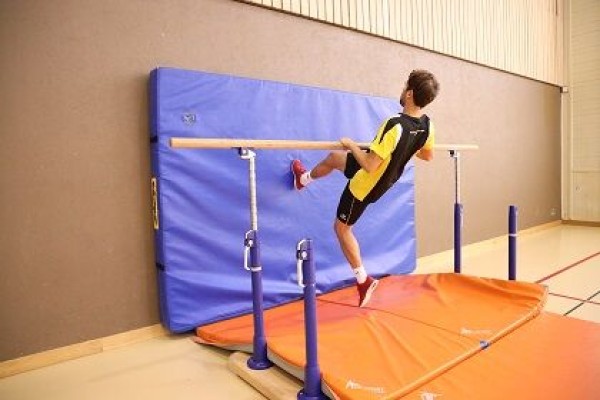
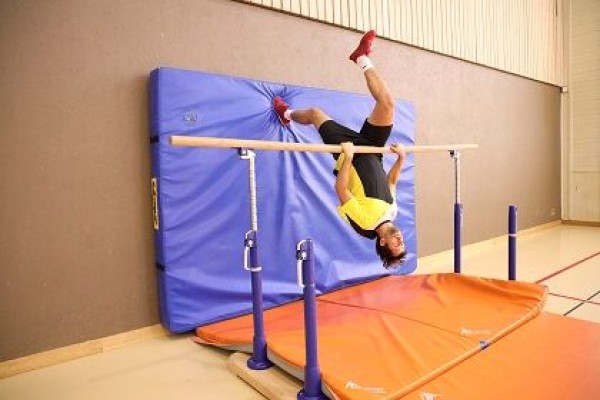
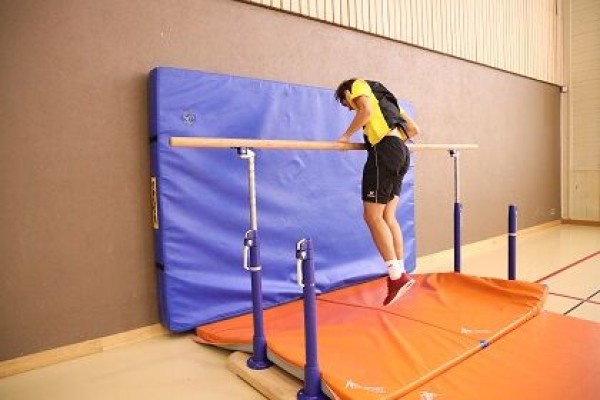
Hold on to the parallel bars with your hands, run up the large soft mat with one or two steps, push off upwards and swing around the parallel bars, resting your head on your neck and landing in the starting position.
Variant:
Exercise performed with a horizontal bar. A large soft mat attached to a vaulting box serves as a "wall".
outdoor:
Hold on to the bar with your hands, perform a powerful push-off with the supporting leg, move the swinging leg over the bar and continue to turn until you reach the support or land safely on the floor again with both legs (hip swing)
1 wall
1 parallel bar
1 soft mat (large)
3-4 soft mats (small)
Variation of the exercise:
1 horizontal bar
1 vaulting box
Indoor set-up:
Place the parallel bar in front of a wall, fix the bars at chest height, place a large soft mat against the wall and lay out a few small soft mats on the floor to secure it.
Variant: Place a large soft mat against a Swedish pole.
Outdoor:
1 pole
Backflip III
Parkour
Group work
Groups of 3

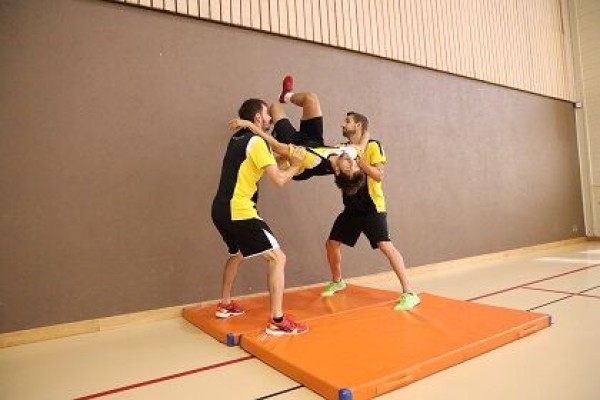

The partners each grab one of the jumper's upper arms from both sides and do not let go until they land safely. Run towards the wall with momentum, run up to shoulder height with one or two feet on the wall and push off, lean your head back and throw your legs in the direction of rotation, turn and land on both legs.
Variant:
Hook a vaulting box top diagonally into the wall bars as an aid and walk up it.
1 wall
2-3 soft mats (small) ► Indoor version
Variation of the exercise:
1 wall bars
1 vaulting box
Backflip IV
Parkour
Partner work

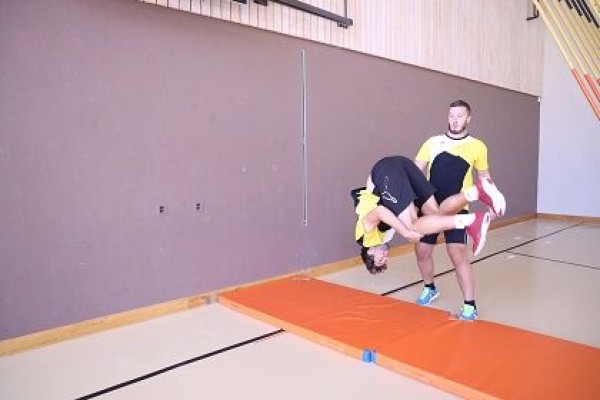
The partner places the hand of the arm further away on the back of the jumper's neck and the other hand on the lower back. The hands accompany the jumper throughout the jump until they reach a safe standing position. Run towards the wall with momentum, run up the wall to shoulder height with one or two feet and push off, rest your head on the back of your neck and throw your legs in the direction of rotation, turn and land on both legs.
Variant:
Hook a vaulting box top diagonally into the wall bars as an aid and walk up it.
1 wall
2-3 soft mats (small) ► Indoor version
Variation of the exercise:
1 wall bars
1 vaulting box
Badminton
Games / Tournament
Game idea:
Two parties try to score a direct point by skilfully hitting the shuttle or to force a mistake by the opposing party.
Scoring:
A point is scored if the shuttle lands in the opponent's court or if the opposing party cannot return the shuttle in accordance with the rules.
Court:
Badminton court, net height 1.55m.
- Singles: inside sideline; back baseline.
- Doubles: outside sideline; back baseline.
- On serve, the court is bordered by the front service line.
Number of participants:
1 against 1 (singles), 2 against 2 (doubles)
Rules of the game:
Each party can score regardless of the right to serve. The player who won the previous point has the right to serve. The serving player must stand within their own service sector and play the shuttle diagonally into the opponent's service sector. If your own score is even, the serve is made from your own right-hand sector; if your own score is odd, the serve is made from the left-hand sector. The serve is served below the waist and the shuttle may touch the net when serving (no repetition).
Doubles:
The right to serve changes to the opponent after a fault. If the right to serve changes, the person serving also changes within the team.
Only one serve per party is allowed. It is considered a fault if the shuttle does not cross the net, touches the wall, ceiling or floor outside the court or if a party or a racket touches the net.
A set goes to 21 points. To win, there must be at least a 2-point difference (i.e. the game continues until one party has a 2-point lead) and it is played to two winning sets.
Badminton: Conscious stroke execution
Forms of play / exercises
Groups of 2
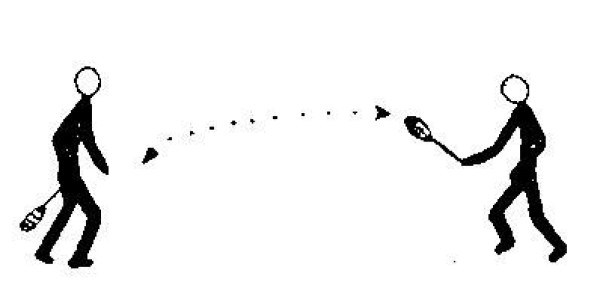
Passing game in teams of two; during the passes, the partner is asked for the type of shot, but before the shuttle goes over the net (e.g. forehand, backhand, overhead, hand change or rotation on its own axis)
Per participant:
1 badminton racket
Per group:
1 shuttle
Badminton: Accuracy
Forms of play / exercises
Groups of 2

Passing game in teams of two; both players stand so that they have little freedom of movement (e.g. on a long bench, a vaulting box or in a hoop)
Variant:
Only one player has limited freedom of movement.
Per participant:
1 badminton racket
Per group:
1 shuttle
2 long benches, vaulting box or tyre
Badminton: Skill
Forms of play / exercises
Groups of 2

Passing game in teams of two; the shuttle should be caught and stopped by the player every third or fifth touch of the ball.
Per participant:
1 badminton racket
Per group:
1 shuttle
Badminton: Controlled hitting and stopping
Forms of play / exercises
Groups of 2
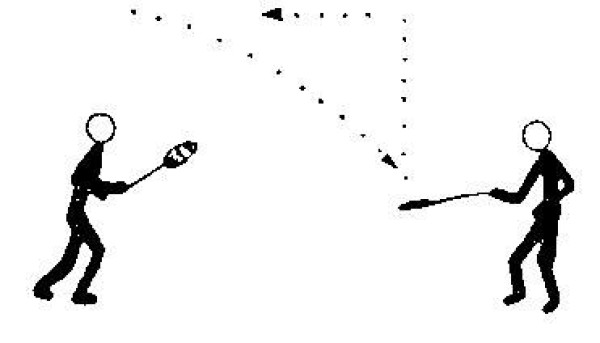
Passing game in teams of two; before the shuttle is hit back, however, it is played vertically upwards and only then hit back again.
Per participant:
1 badminton racket
Per group:
1 shuttle
Badminton: Circle game
Forms of play / exercises
Group work
6-8 participants form a circle. The game is played with a shuttle, which should stay in the air as long as possible.
Variant:
Multiple shuttles.
Per participant:
1 badminton racket
Per group:
1 shuttle